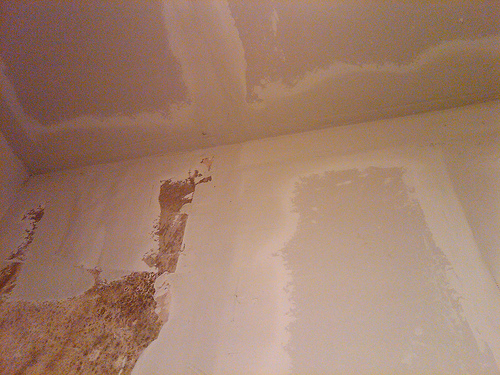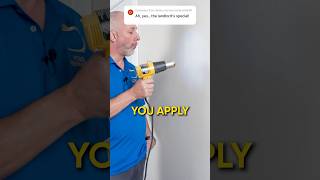[post_name drywall supply Drywall Repairs Made Simple

Drywall imitates a sponge, soaking up dampness at every opportunity. When drywall splashes, it swells and bends, jeopardizing the integrity of your wall. This permits the underlying structures to experience extended exposure to wetness and begins the disintegration procedure, ultimately rotting the whole framework. Drywall is a functional structure product, however. Drywall that has actually gotten wet could be repaired with a little know how.In order to repair wet drywall, follow the below steps:
o Eliminate around the influenced drywall with a drywall saw. These handsaws are sold reasonably at any regional equipment store. Make sure that you reduce away all affected drywall by preserving vast margins around the defect.o Determine the reason for the water. This step is somewhat simple if your drywall was affected by an outdoors force like rain, flooding, or a damaged hot water heater, yet might be a bit more evasive if you have a roofing system or pipes trouble. If you can not ascertain the source of the water, ensure you call a professional.o Change the wet
drywall with completely dry. On a new item of drywall, define a spot of new drywall in the very same measurements as the old as well as reduced out with a razor knife or drywall saw and also screw into the open hole. If there is no wall stud behind the open area, removed the existing drywall till there is a subjected stud on either side of your repair.o Apply drywall mud. Joint compound of drywall mud is used in layers. Make the very first layer the thickest, covering all the joints extensively and also enable to dry. Do not fret also much about making the substance totally smooth as there will certainly be several layers of mud and also sanding prior to you reach your finished coat. All the mud to dry and afterwards sand smooth. Run your turn over the joints, really feeling for reduced or high areas and also mark with a pencil. Continue sanding high spots and after that include a new layer of mud over the entire repair service, focusing on including substance to the reduced places. Repeat this process till your fixing is level with the existing wall.o Tip: Take your time with this step, as your mud work is the key to having a smooth
wall surface later.o Paint-Repaint your whole wall to ensure that the color suits. Even if you have actually the paint tinted to match your
existing wall, the shades could not match 100 %, offering you an obviousing tip of where the repair service happened. While you do not have to, you could choose to paint the entire space to make certain shade evenness.This technique functions well for tiny drywall repair work tasks, but in circumstances where there are big areas of drywall to replace, such as a flooding circumstance, it could be advisable to call a professional.http:// www.rightwayrestoration.com
DIY Versus Professional Drywall Installation and Repair
The technique for ways to get rid of drywall structure depends on the product being gotten rid of and also the problem of the wall surface. The most usual method for removing texture from painted drywall calls for fining sand off the high sections of the texture and filling it in with at the very least 2 thin layers of joint compound - called skim covering. One more technique for unpainted distinctive wall surfaces as well as ceilings, consisting of snacks ceilings, is spraying water on the surface to loosen up the structure so you can scrape it off.When a wall has
comprehensive splits, peeling paint or water damages, it may be easier to cover the existing wall surface with 1/4 -inch drywall or get rid of the existing wall surface totally as well as change it.Whatever technique you use to eliminate a distinctive surface from drywall, secure on your own from exposure to building dirt, lead and asbestos.Removing textured wall surface areas is a rigorous procedure that takes patience.
Below's how you can tackle some usual problems so your wall surfaces will certainly be smooth and your work, profitable.How to get rid of drywall structure by skim finishing Trouble: Irregular surface.Solution To stay clear of producing an irregular wall when you're removing the texture, do not make use of a belt sander. It will certainly collect the appearance.
Rather, get rid of high tops in the appearance utilizing a pole sander with 120 grit or a 5-inch flooring scraper.Problem: Bulgy looking patches.Solution Eliminate any kind of loosened material with a tight brush, scratch high areas and also clean with a wet fabric. To apply the initial coat of joint compound, start on top and work throughout and down. "The most important point is not to use way too much material ,"says Ivan Solis, president of Chicago-based Solis Building and construction."If you utilize way too much joint compound, it will certainly be hard to achieve a smooth surface area. You'll have to do a lot of sanding. "Don't worry concerning ripples, just attempt to cover the structure and also obtain an even layer on the wall surface. Hold the joint knife at a 30-degree angle as well as press it in. "Keep it tight as well as smooth,"says Solis, that advises using a 10 -or 12-inch joint knife.Alternate the instructions of the skimming strokes with each brand-new layer of mud. If you apply the initial coat flat, use the second layer up and down. Return excess mud from the surface area to the rim of the pan, keeping the blade of the blade clean.When the very first layer is completely dry, use the 2nd layer to fill out the surges. Once again, start on top in the corner as well as work throughout and down. As you function, knife off any big chunks of the first coat, utilizing your blade. If there are still reduced and also high spots, you might need a 3rd layer. When the coat is completely dry, coating with a last sanding.Problem: Joint substance that sets too rapidly or is too tough to sand.Solution Choose the ideal substance for the task. When a wall structure will require numerous layers of joint compound to smooth the surface area, make use of a setting substance like Sheetrock Easy Sand for the initial layer."Easy Sand 90 is a chemically establishing compound that will provide you roughly 90 mins to function before it establishes,"says Jeff Hartin, product manager for USG's Ready Mixed items. The item is ideal for hefty fills and sands quickly."The nice thing about a setup substance is that you could use the very first layer and also begin a second coat when the first one has actually hardened,"claims Solis.For the second or final coat, Hartin and Solis recommend a ready-mixed joint compound, such as Sheetrock And also 3. The lightweight product is less complicated to spread out, permits a thinner application, as well as is easier to sand.Problem: Discolorations leach via the joint compound.Solution These troubles are frequently as a result of incorrect attachment and are common on numerous Do It Yourself painting tasks. If the distinctive wall surface is peeling off or plaster as well as textured joint compound are dropping off, get rid of loose material with a scraper, sand as well as coat the surface area with primer/sealer prior to skim coating.Problem: Cracks and dents reappear.Solution Repair fractures and dents before skim coating. To fix them, tape over the splits with drywall tape and also secure them with joint compound. When the wall is smooth, a drywall guide and also sealant will secure the
wall surface as well as assistance stop splits and dents from reappearing. Primer also neutralizes the pH of the wall for a much more also appearance.Problem: Peeling off paint and gurgling in the paint finish.Solution These problems are typically due to improper attachment. If the distinctive wall surface is peeling or plaster as well as textured joint substance are diminishing, remove loosened material with
a scraper, sand and also coat the surface with primer/sealer prior to skim coating.Problem: Pitting.Solution Pits on the surface of the drywall are air bubbles that were not properly loaded or that were subjected during fining sand. Air gurgles result from over -or under-mixing the joint substance. Apply pressure to the bubbles with the joint blade, up until the pits are gone. If you don't discover them until the wall surface is dry, cover them with joint substance and also sand.Problem: Over-sanding; missing high as well as reduced spots.Solution Sand way too much and you run the risk of harming the surface paper. If that occurs, cover the area again with joint substance. To stay clear of missing out on high as well as reduced spots, make use of a clamp-light or other light source close to the wall to find trouble areas. Sand carefully, functioning from the ceiling to the floor in slim sections.How to remove a textured surface from drywall by scratching
Problem:
Wall surface damaged by water and also scrapers.Solution Specialists suggest wetting wall structures with a spray bottle to loosen up the material. After that utilize a scraper with a level, large blade to remove the texture. Use only sufficient water to loosen up the material or you could harm the drywall. If you note the sheetrock with the side of your scraping blade, spot it with joint compound.How to eliminate a textured surface from drywall by covering wall surfaces with drywall Issue: Reinstalling trim.Solution "One point to maintain in mind when using 1/4-inch drywall over an existing
wall is that not only will your wall, door as well as home window covering look a 1/4- inch thinner however every one of the "joints"will need to be loaded with joint compound and caulked, "claims Solis. You may need to remove trim and reinstall it, as well as electric outlets might need expansions to bring them purge to the wall surface.

DIY - How to Repair Drywall Seams
Drywall repair North Bay Village - drywall texture
